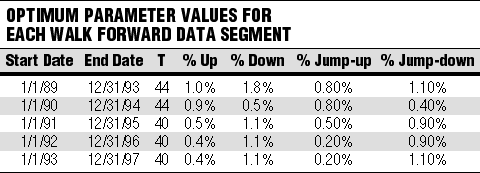
The British pound (BP) is a major currency traded worldwide by corporations, institutions, banks, commodity funds and futures traders. The BP is traded 24 hours a day, and most of the world's largest banks make a two-sided market in the British pound and its associated derivatives. Small traders, however, are constrained to trade the BP futures on the Chicago Mercantile Exchange (CME). The BP futures are traded daily from 7:20 am to 2 pm on the CME and from 2:30 pm to 7:05 am Monday through Thursday, and then 5:30 pm Sundays to 7:05 am Mondays and holidays on the CME Globex system. While the CME BP futures trading volume is small when compared with total worldwide bank and institutional trading volume, arbitrage keeps the futures prices in line with the bigger markets.
NEW TECHNIQUES
The British Pound, Cubed
by Dennis Meyers, Ph.D.
Currency markets are popular with trend-followers because of the tendency for currency markets to follow long-term trends. Still, there is the challenge of recognizing the end of one trend and the start of another. Meyers explains a technique of smoothing out the trend and recognizing the major turns.
DATA DISCUSSION
The BP futures contract on the CME trades in the quarterly cycles of March, June, September, and December. The current active BP futures contract is the BP September 1998 contract. This is the CME futures contract that expires on the second business day before the third Wednesday of September 1998. The BP December 1998 contract will become the active contract one week before the September 1998 expiration day.
The British pound is the currency of the United Kingdom. Each BP futures contract is worth the dollar value of 62,500 British pounds. On May 29, 1998, the BP June 1998 contract closed at 1.6302 dollars per BP, making one BP contract worth $101,887.50 (1.6302 multiplied by 62,500). The BP futures contract trades in units of $0.0002 per BP, and so, a move of one tick of $0.0002 is worth $12.50 per contract ($0.0002 $/BP multiplied by 62,500 = $12.50).
BP futures started trading on 1975. However, for our purposes here, we will limit our study to the price history from January 1, 1989, to today. Here, we will use a BP futures continuous contract. Since BP future contracts expire each quarter, a continuous contract is built by switching to the active contract on rollover day and back-adjusting the difference in prices between the new contract and the old, thus creating a smooth continuous contract.
The performance results from systems using continuous contracts cannot match actual results from trading real contracts because of the costs of actual rollover and execution slippage. Execution slippage is the difference in prices from actually executing an order when a buy or sell signal is given and the price at which the computer system assumes that the order was executed. When rolling over in real time via actual executions, the difference in prices between the new contract and the old on rollover day may not be the same as the closing prices that the computer uses to construct the continuous contract.
Another problem with continuous contracts is that the past data is back-adjusted by the difference in prices between the two contracts on rollover day. Systems developed on continuous contracts that use some form of percentage of prices will be affected by this difference adjustment to past prices. Despite these qualifiers, system results based on continuous contracts are still indicative of the worth of the trading system.

Excerpted from an article originally published in the November 1998 issue of Technical Analysis of STOCKS & COMMODITIES magazine. All rights reserved. © Copyright 1998, Technical Analysis, Inc.